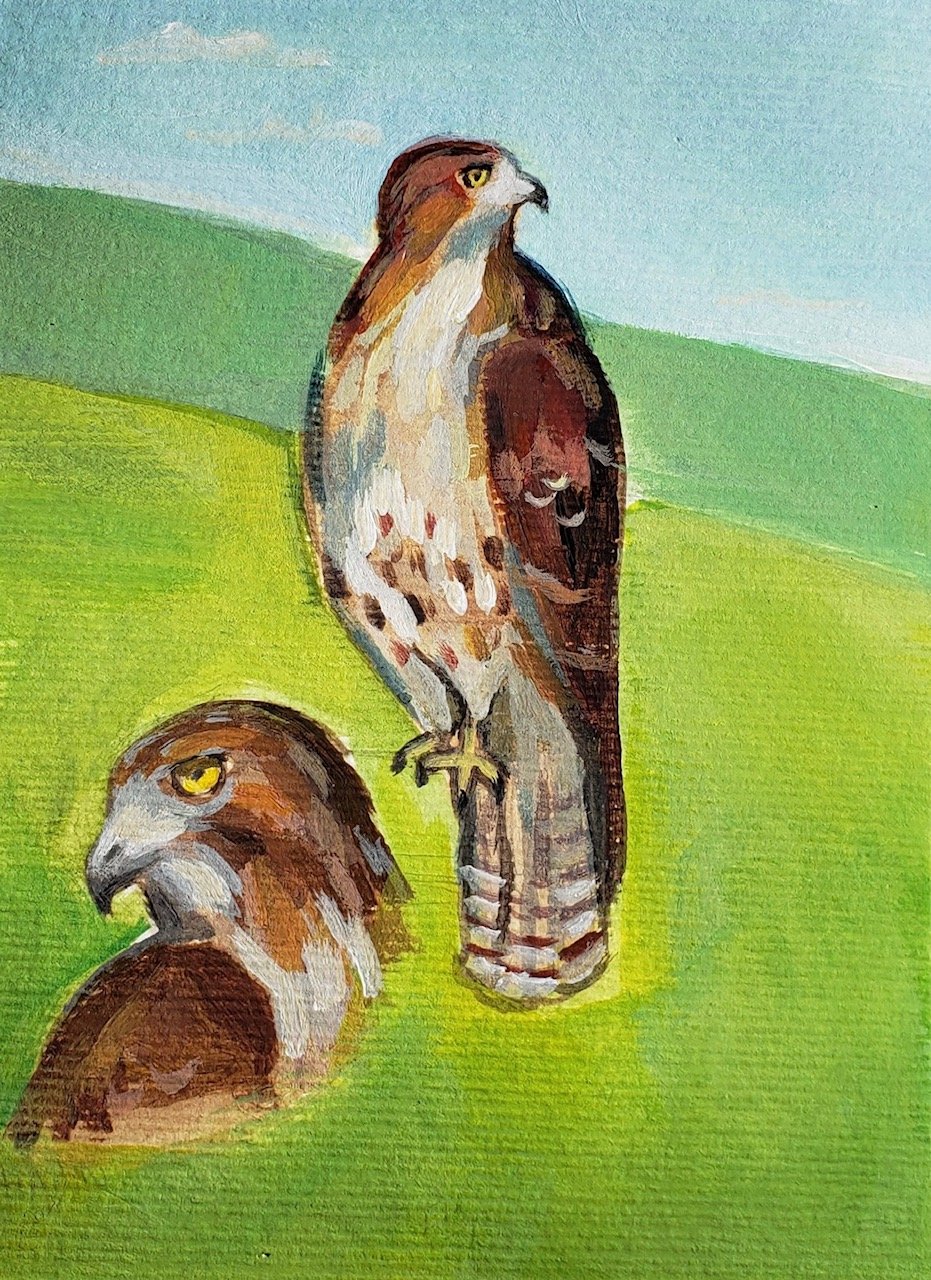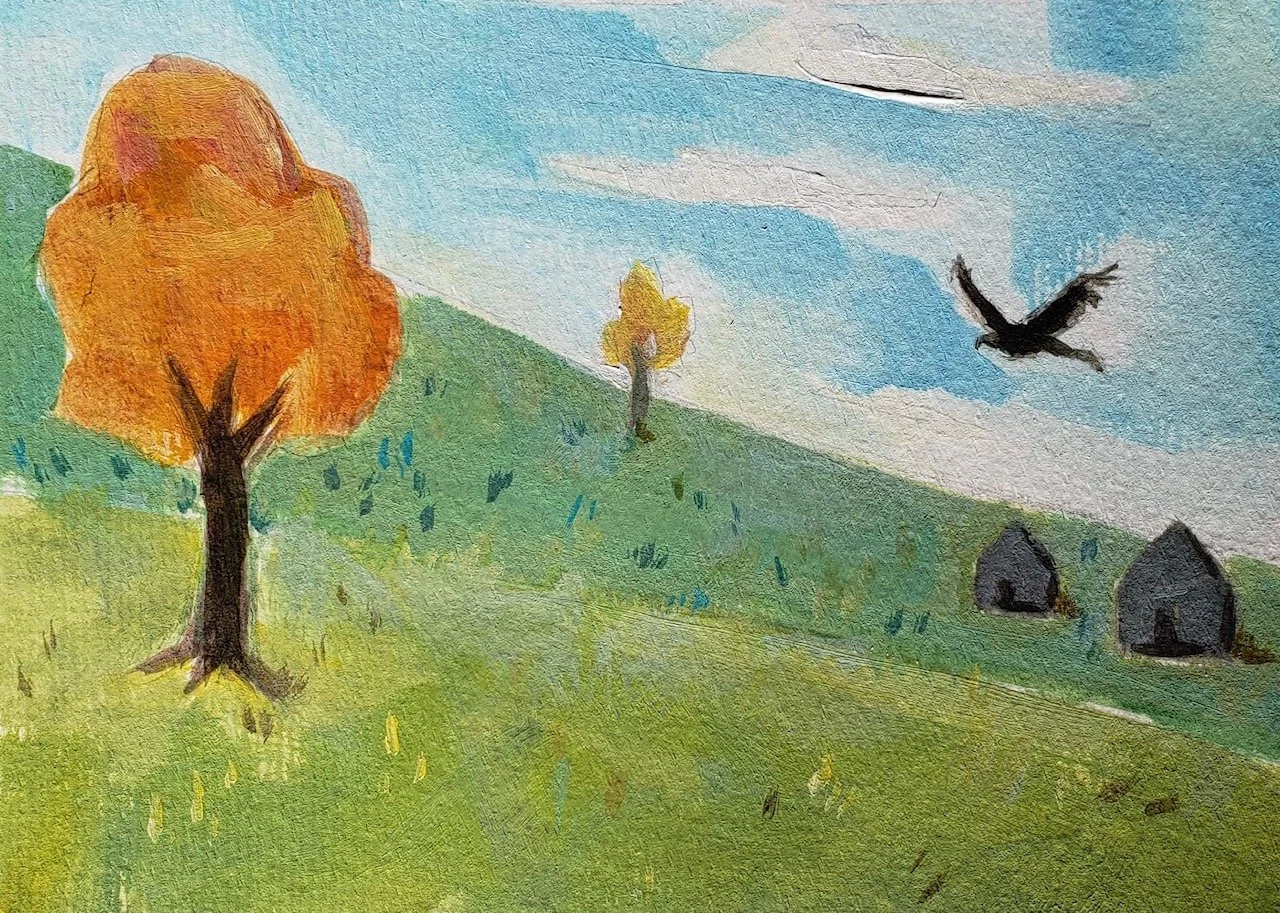Finding Hawk Parallax: My Son & The Birds
(This essay was first published in FieldTripping.)
Every week or so in the summer months, I drive my nine-year-old son Joseph an hour to a woodlot near a conservation trail in Newcastle, Ontario. Here Sam, his falconry sponsor, shows Joe how to offer a Harris Hawk her first live kill: a pigeon.
Joe stands resolute and alert as the hawk swoops toward him from her high ring perch about 20 feet away, her four-foot wingspan materializing miraculously from her 780-gram body. As Sam has instructed, Joe gives a sharp tug on the lure holding the pigeon, which has been lying still near Joe’s feet. The tug excites movement from the bird and keeps the hawk focused.
This isn’t the first time I’ve stared on in breathless amazement as my son—the same kid who seldom speaks up in ining Hawk Parallaxclass, doubting his academic intelligence to the quick; the same kid who had an existential crisis playing baseball, standing in the middle of the outfield, a ball hurtling toward him, screaming, "What's the point of any of this?”—engages with birds of prey with respectful, cautious confidence.
Art by New Mexico artist Catie Powe.
“Mom, look!” Joseph shouts over his shoulder as he watches the hawk mantle around his kill. Mantling, Sam had explained to us during our first workshop with him, is how these birds protect their meal. They spread their wings wide, encircling the food to guard it against possible poachers.
Joseph is a falconry apprentice. After seeing a falconer during a Medieval Times show in Toronto, Joe was enraptured. While falconers do not abound in Ontario, I found Sam easily enough and set up an OFC workshop for our family in mid-April. Two of my four children—the youngest two—were so frightened by the birds they spent the workshop in the van with my husband. Joseph, who was eight years old at the time, and my eldest daughter stayed the course, feeding hawks and eagles and owls meaty chunks of quail from their gloved hands. But whereas my daughter meandered back to the van to listen to a Taylor Swift CD after the workshop, Joe stayed, following Sam around as he packed up the birds and asking dozens of questions.
“What were those small, yellow balloon-like balls that the birds didn’t eat?”
“Eggs,” Sam explained, picking up a massive Golden Eagle who had fallen off her perch. “We feed the birds spent hens, so they have multiple eggs still in them.”
“And what would happen if you took off her hood right now?” Joe probed, nodding to the eagle Sam had just sat back on the rail. The hoods are fastened over the birds’ heads, covering their eyes when they aren’t flying. This gear helps keep the birds calmer and the handlers safer.
“She’d probably try to tear my face off,” Sam answered. “Again.” He added, pointing to a blood-crusted scab running from his lip to about an inch up his cheek. He’d told us of how he’d put his face too close to the eagle and she’d made a grab for his mouth, ripping through his skin with her sharp, powerful beak.
It was a stupid mistake, he said. He’d known better. The same eagle had taken down a coyote a few weeks before, and another had put her talons right through Sam’s forearm. There are a few of the birds Sam admits he won’t fly alone; they’re that dangerous.
He reassured me and Joe: just follow the rules, stay vigilant and there’s little chance of getting hurt.
During that first workshop, Sam also explained that movies like Harry Potter had made owning owls and other birds of prey trendy, but most of the new bird owners were in over their heads. Eagles, hawks, and owls are demanding, temperamental and highly aggressive animals—the closest living relatives to coelurosaurian dinosaurs. A few of his roughly 100 birds have been surrendered by people who could not care for them. Sam works with these birds toward readjustment and eventual return to their owners or release.
Many of Sam’s other birds have been brought in by wildlife officials when they’ve been hit by vehicles. Some can be released given time, and others are not fit to be released again, whether it be because of their age when they were brought in (too young and spent too much time with people to be released) or the nature of their injuries. Young male Harris hawks are particularly prone to injury. Like most young males, they’re stupid, Sam joked.
It’s easy to laugh with Sam. He has an unpretentious, rough charm that helps you feel comfortable around these prehistoric-looking raptors.
“But remember these aren’t pets,” he told Joe again. “These are deadly animals and they’d kill you given the chance.” The eagle he’d sat back on her perch screamed. "This one acts like I'm the bane of her existence," Sam said, stroking her breast feathers. "She's probably right."
I have mixed feelings about keeping these terrifying, beautiful creatures bonded and contained. From an education and conservation standpoint, I can see how the practice of falconry has merit, but I’m also left with the same feeling I had after swimming with dolphins in Cuba, many of which were also rescues: just let them go.
Suffice it to say I haven’t made any peace with the ethical implications of falconry. My son, on the other hand, addressed my concern frankly. “Mom,” he said, sounding a little exasperated. “I don’t know how to explain it, but the world feels better after being with the birds.”
Letting my son handle birds of prey is hardly a decision I take lightly. However, Sam is a diligent teacher and this activity, in one summer, caused less physical harm than most kids experience in a week of playing rec hockey or football. And by less injury I mean none. Joe has left each session with Sam with nary a scratch. That doesn’t mean that injury won’t happen, only that there’s an element of risk to everything and Joe is learning how to manage that risk by forming respectful relationships within the natural world.
Of course, I still worry. But as I see my son come into his own under Sam’s careful tutelage, I see there is far more to gain than to lose.
After that initial workshop, I’d emailed Sam and asked to set up another, just for Joe. Sam replied, “How about he just comes and helps me with the next workshop?”
By the end of that session, Sam had given Joe his own falconers glove and, when I asked if I could pay for lessons, he offered to take Joe on as an apprentice—an honour considering many falconers don’t take apprentices and Sam hadn’t had one in years. Joe would help Sam with workshop preparation and clean up and while doing so, he would learn about falconry.
“Are you sure?” I’d asked, elated but also feeling that the opportunity was too good to be true. My son, who often felt so out of place in much of his day-to-day world, would have a place to feel confident and more like himself—more like the person he wants to be.
“Sure,” Sam said, unleashing another easy smile. “He’s got the passion. Reminds me a lot of myself at his age.”
“Sam had a sparrow hawk at my age!” Joe interjected, beaming. I think of how kids at his school have called his smile creepy. It’s not his real smile they’re referring too. It’s a facial tick he’s had since he was a toddler. Whereas his real smile is unrestrained and breathtaking, his tick smile is anguished and strained—an unconscious muscular reaction to feelings of discomfort or stress. I think of how much I see him smile—really smile—when he’s training with Sam.
American climber and noted outdoor educator, Willi Unsoeld once said, “You go to nature for your metaphysical fix—your reassurance that the world makes sense. It’s reassurance that there’s something behind it all and it’s good, you come back to where people are, to where people are messing things up, because people tend to, and you come back with new ability to relate to your fellow [people] and to help your fellow [people] relate to each other.”
I looked at Joe standing there smiling in the sun-washed clearing, gently petting the Great Horned Owl he was returning to her carrier.
“Huh, Mom? Whaddya say? A sparrow hawk?” He raised his eyebrows at me in a teasing, expectant wiggle. “They’re so small, you won’t even notice one.”
I beamed right back at him. “I say don’t get ahead of yourself, kid.”

